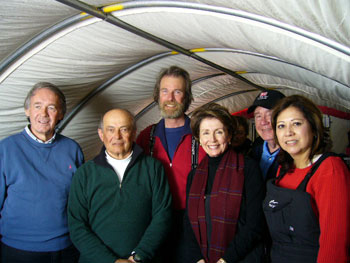|
Web Extra Thursday, June 7, 2007
Snowmelt on the rise in Greenland
 U.S. House of Representatives |
| Over Memorial Day weekend, a delegation from the House Select Committee on Energy Independence and Global Warming visited Greenland to learn more about how snowmelt is increasing on the Greenland ice cap as global temperatures increase. From left to right: Rep. Edward Markey (D-Mass.); Jay Zwally, NASA Goddard Space Flight Center; Konrad Steffen, University of Colorado at Boulder; House Speaker Nancy Pelosi (D-Calif.); Rep. Dave Hobson (R-Ohio); and Rep. Hilda L. Solis (D-Calif.). |
Amid growing public awareness about global warming, a new
study is adding fuel to the fire. The study, which uses satellite observations
of Greenland's ice sheet, is showing that Greenland experienced more days of
melting snow in 2006 than the country had averaged over recent decades.
"Snowmelt occurred more than 10 days longer than the average over the past
18 years in some areas of Greenland," says Marco Tedesco of the Joint Center
for Earth Systems Technology at NASA Goddard Space Flight Center and the University
of Maryland, Baltimore County, and author of a study published May 29 in Eos.
Furthermore, snowmelt occurred at higher altitudes than average in 2006, Tedesco
wrote. Such melt data help researchers to understand more about how glaciers
flow, and thus how quickly Greenland's ice may respond to a warming climate.
"There are several reasons why the melting of Greenland's ice sheets should
be cause for concern," Tedesco says. Meltwater can provide a source of
freshwater to the ocean, which can raise sea levels and wreak havoc on North
Atlantic circulation and the climate (see Geotimes,
November 2005). "Meltwater can also percolate through the ice sheet
and lubricate the bedrock and ice interface," Tedesco says, which may contribute
to ice sheet sliding and loss (see Geotimes,
March 2006).
Using the Special Sensor Microwave Imaging radiometer (SSM/I) onboard the Defense
Meteorological Satellite Program spacecrafts, Tedesco measured the electromagnetic
signal naturally emitted from the snow at microwave frequencies on Greenland
to detect the presence of liquid water from melting snow. "This signal
increases when liquid water is present in the snowpack," Tedesco says.
"Another reason for studying melting snow is that dry and wet snow appear
similar to the human eye," Tedesco says, "but they absorb solar radiation
in a different way, as wet snow absorbs four to five times more energy from
the sun than dry snow."
To analyze the SSM/I data, Tedesco used concepts called the melting extent and
melting index. The melting extent is the area experiencing melting for at least
one day, while the melting index is the area of melting multiplied by the number
of days of melting. "Although the melting index and melting extent were
not at a maximum in 2006," Tedesco says, "both the melting extent
and index followed the increasing trend observed from 1988 to 2005."
Previous studies by Jay Zwally and Waleed Abdalati of NASA's Goddard Space Flight
Center and Konrad Steffen from the University of Colorado at Boulder have shown
a correlation between increased surface meltwater and the speed that the glaciers
on the ice sheet flow out to sea (see Geotimes,
July 2006). Tedesco is currently working on extending the dataset back further
to see how long the melting trend has been occurring.
"What is causing the melting and how this is related to mass changes and
sea level rise are fundamental questions, both for the scientific community
and the public at large," Tedesco says. "There are many factors that
influence melting," he says. "The information these satellites give
us is what is happening. Why it is happening requires a community
effort to decipher and, in this sense, the ongoing International Polar Year
offers an unique opportunity."
Links:
"Salting
a stagnant ocean," Geotimes, November 2005
"Arctic
Amplification," Geotimes, March 2006
"H.
Jay Zwally: Glaciologist by chance," Geotimes, July 2006
NASA
press release on congressional visit to Greenland
Back to top

 Subscribe
Subscribe


